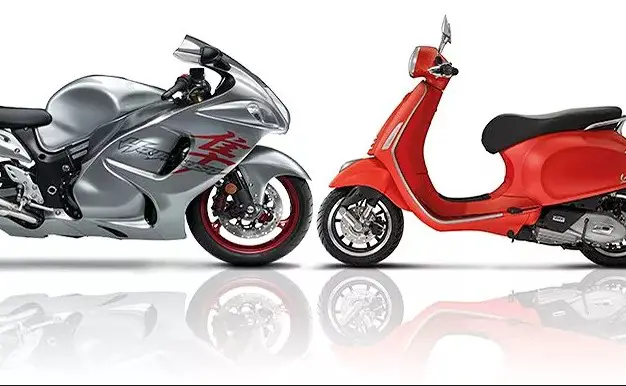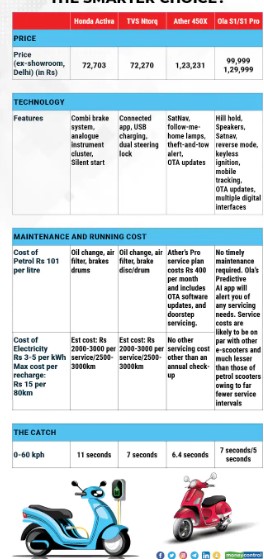Choosing between a scooter and a motorbike is more than just picking a mode of transportation; it’s about selecting a companion for your daily commutes, adventures, and everything in between. Each option offers distinct advantages, tailored to different needs, lifestyles, and preferences. From the bustling streets of urban landscapes to the winding roads of rural areas, the choice significantly influences your riding experience, comfort, and convenience.
The key difference between scooters and motorbikes lies in their design, engine size, and intended use. Scooters feature a step-through frame and a platform for the rider’s feet, making them more comfortable for city commuting. Motorbikes, with their larger engines and fuel tanks, are built for longer distances and varied riding conditions. This fundamental distinction caters to a wide array of preferences and requirements, ensuring there’s a fit for every type of rider.
Scooters and motorbikes each present unique advantages, from the ease of handling and maintenance to the thrill of high-speed cruising and off-road adventures. The decision between the two ultimately depends on the rider’s priorities, such as fuel efficiency, comfort, performance, and the intended use of the vehicle. Understanding these differences enables riders to make informed choices, ensuring they get the most out of their two-wheeled journey.

Design and Build
Scooter Features
Scooters stand out with their step-through chassis and floorboard, offering a distinctive design that caters to comfort and convenience. Unlike traditional motorcycles, scooters are designed with a frame that allows riders to mount and dismount easily, making them an ideal choice for those looking for a user-friendly option. The presence of a floorboard not only provides a space for resting the feet but also contributes to the scooter’s stability by lowering the center of gravity.
The compact nature of scooters, coupled with their enclosed mechanics, offers a sleek and tidy appearance while protecting the rider from the elements and road debris. This design philosophy extends to the storage capabilities, with many scooters featuring built-in under-seat compartments and additional luggage options, enhancing their practicality for everyday use.
Motorbike Structure
Motorbikes, on the other hand, showcase a diverse range of frames and seating positions, designed to accommodate a variety of riding styles and purposes. From the upright stance of standard bikes to the forward-leaning position of sports models, each structure is engineered to optimize control, comfort, and performance. Unlike scooters, motorbikes often feature exposed engines and mechanics, highlighting their power and engineering prowess.
The frame of a motorbike is crucial in defining its handling characteristics, with materials ranging from lightweight aluminum to durable steel. This variation supports different riding demands, from the agility required in racing to the stability needed for touring. Additionally, the seating position on motorbikes is designed to align with the vehicle’s overall performance goals, influencing rider ergonomics and control.
Engine and Performance
Scooter Mechanics
Scooters are typically equipped with smaller engines ranging from 50cc to 250cc, making them well-suited for city commuting and short-distance travel. These engines often utilize an automatic transmission, simplifying the riding process by eliminating the need for manual gear changes. The performance of a scooter is tuned for efficiency and ease of use, offering adequate power for navigating urban environments and achieving respectable fuel economy.
The typical usage scenarios for scooters include daily commutes, errand running, and short leisure rides. Their engine size and performance capabilities reflect this focus on practicality, offering riders a balance of speed, convenience, and cost-effectiveness.
Motorbike Power
Motorbikes boast a wider range of engine sizes, from 125cc to over 1000cc, catering to a broad spectrum of riding experiences. This variance in engine size translates to significant differences in power output and performance capabilities, with some models designed for high-speed racing and others for off-road adventure or long-distance touring.
The choice of engine size in a motorbike directly impacts its suitability for different types of riding. Smaller engines are favored for city use and beginner riders, offering manageable power and fuel efficiency. Larger engines, however, provide the thrust needed for highway travel, competitive racing, and carrying passengers or cargo over longer distances.
Riding Experience
Ease of Use
The design and mechanics of scooters contribute significantly to their ease of learning and urban commuting efficiency. The automatic transmission eliminates the learning curve associated with manual shifting, allowing new riders to focus on navigation and safety. Additionally, the compact size and lighter weight of scooters make them easy to maneuver through traffic and park in tight spaces, enhancing the urban commuting experience.
Handling and Control
Motorbikes require a higher level of skill for effective handling, primarily due to their manual transmission and control complexity. Riders must master clutch engagement, gear shifting, and throttle control to navigate different riding conditions successfully. This learning process, while more demanding, offers a greater degree of engagement and satisfaction for many riders.

Use Cases
Scooter Suitability
Scooters shine in urban environments and for short trips. Their compact size and agility make navigating through city traffic a breeze. Ideal scenarios include:
- City commuting: Scooters can easily weave through congested streets, offering a quick and efficient way to get to work or run errands.
- Short trips: For quick jaunts to the grocery store or local café, scooters offer ample storage and convenient parking.
- First-time riders: Their ease of use makes scooters a great option for those new to two-wheeled transport.
Motorbike Applications
Motorbikes demonstrate versatility across a range of uses, from urban commuting to adventure riding. They excel in:
- Daily commuting: Especially in less congested areas where their speed and power can be fully utilized.
- Long-distance touring: Built for comfort and equipped with larger fuel tanks, motorbikes are ideal for cross-country journeys.
- Adventure and off-road: Specific models are designed to tackle rough terrain, opening up a world of exploration.
Cost and Maintenance
Initial Investment
The purchase cost of scooters vs. motorbikes can vary widely:
- Scooters: Generally more affordable, with prices varying based on engine size and features. Ideal for budget-conscious buyers.
- Motorbikes: Can be significantly more expensive, reflecting their larger engines, advanced technology, and performance capabilities.
Upkeep and Repairs
Maintenance needs differ notably:
- Scooters: Typically require less maintenance, thanks to their simpler mechanics and smaller engines. This translates to lower overall costs.
- Motorbikes: With their complex systems and high-performance parts, motorbikes can be more demanding and expensive to maintain.
Safety Considerations
Scooter Safety Features
Scooters incorporate features like automatic transmissions and lower speeds, which contribute to safety. However, their smaller size can make them less visible on the road. Riders are encouraged to use reflective gear and practice defensive driving.
Motorbike Safety Measures
Motorbikes offer advanced braking systems and better tires for enhanced safety. Riders should invest in quality helmets, jackets, gloves, and boots. Formal training courses are also highly recommended to improve riding skills and safety awareness.
Environmental Impact
Fuel Efficiency
- Scooters: Known for their excellent fuel efficiency, scooters are ideal for eco-conscious individuals looking to reduce fuel consumption and costs.
- Motorbikes: While less fuel-efficient than scooters, newer models have made significant improvements. Larger engines and performance capabilities generally mean higher fuel consumption.
Emissions
Both scooters and motorbikes contribute to emissions, but scooters tend to have a smaller carbon footprint due to their smaller engines and higher fuel efficiency. Efforts are being made to introduce electric models, which offer a cleaner alternative.
Legal and Insurance Aspects
Licensing Requirements
- Scooters: Many places allow riders to operate smaller scooters with a basic driver’s license, but this can vary.
- Motorbikes: Generally require a specific motorcycle license, involving a written test and a riding exam or course completion.
Insurance Costs
Insurance for scooters is usually less expensive than for motorbikes, reflecting their lower cost, smaller size, and the perception of being less risky to operate. However, factors like engine size, rider’s age, and riding history can influence premiums for both vehicle types.

Frequently Asked Questions
What is easier to ride, a scooter or a motorbike?
Scooters are generally easier to ride than motorbikes due to their automatic transmission, lighter weight, and lower power output. This makes them an ideal choice for beginners or those looking for a simple, convenient mode of transportation for city commuting.
Can I use a scooter for long-distance travel?
While scooters can be used for longer distances, they are best suited for city commuting and shorter trips. Their smaller engines and fuel tanks make motorbikes a more comfortable and practical choice for long-distance travel.
Is maintaining a motorbike more expensive than a scooter?
Typically, maintaining a motorbike can be more expensive than a scooter due to the larger engine size, more complex mechanics, and higher performance parts. However, the actual cost can vary depending on the model, usage, and maintenance practices.
Do I need a special license to ride a scooter or motorbike?
Licensing requirements vary by country and state. Generally, scooters with smaller engine sizes may require a different license than motorbikes. It’s essential to check local regulations to ensure compliance.
Conclusion
The journey through the differences between scooters and motorbikes reveals a landscape rich with options tailored to every rider’s needs. Whether it’s the simplicity and convenience of a scooter for urban adventures or the power and versatility of a motorbike for the open road, the choice profoundly impacts the riding experience. As we navigate the paths of personal preference, lifestyle, and purpose, the decision between a scooter and a motorbike becomes a cornerstone of our journey, shaping each ride into an adventure uniquely our own.
In the end, the distinction between these two forms of transportation extends beyond mere specifications and into the realm of personal expression and freedom. Choosing between a scooter and a motorbike isn’t just about selecting a mode of transport; it’s about embracing a lifestyle that resonates with your individual spirit of adventure, convenience, and passion for the road.
